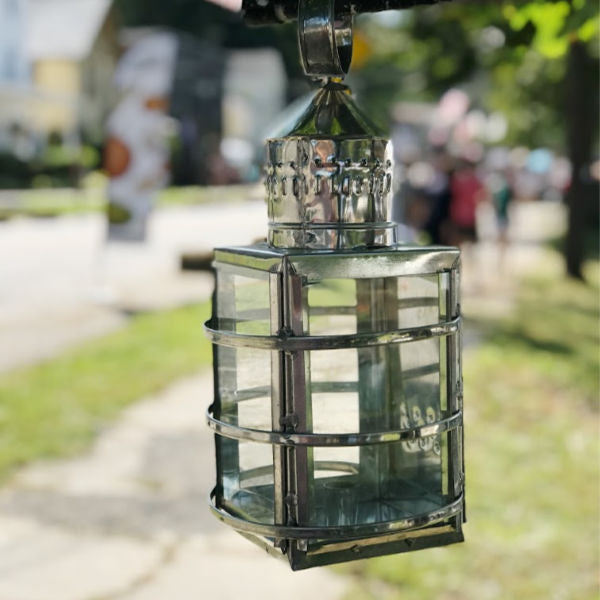See what Art Thorman makes >>
Few of us give much thought on a daily basis to how the glassware, cutlery, and plates we use daily were made. Perhaps most of us think of these items as machine-made, easily replaced, and fairly interchangeable. But back in Colonial times, people had a personal relationship not just with their cups and saucers, but also with the folks who made them. Most places had — in addition to a butcher, a baker, and candlestick maker — a tinsmith who fabricated forks, spoons, cups, plates, and decorative items from sheets of iron.
The process of making tinplate, when sheet iron is coated with tin and run through rollers, was discovered in the 16th century in southern Germany and Bohemia, now part of the modern-day Czech Republic. Tin, contained in cassiterite, was mined primarily in Cornwall. The Brits kept the process of tinplate production a secret and sent it as a raw material to production hubs. In the late 17th century, researchers say that industrial spies spilled the beans. Once manufacturers learned how to make it themselves, the practice spread.
Tinsmiths arrived in American colonies from England in the mid-17th century, and the practical and useful art soon gained new recruits. An apprenticeship of four to six years with a tradesman — often entailing basic work at first, like the polishing of tools. Then newbies were entrusted to keep fires lit and file edges. Eventually, they were allowed to trace patterns, cut out, and complete objects. Each step was required to understand and master the art of tinsmithing.
However, the British Iron Act of 1750 prevented colonists from erecting new rolling mills, which meant that tinplate production didn’t occur in the United States until after the American Revolution. Until then, the production material had to be delivered over long sea voyages.

During the Revolution, tinsmiths and their work were in great demand, as the military wanted inexpensive and lightweight but dependable drink and foodware, plus lanterns.
In short, tinsmithing, indisputably practical and relatively inexpensive, but with plenty of room for whimsy and creativity in execution, is considered by many to be synonymous with the early American arts and craft movement. Which may be how Art Thorman, a former history teacher, ended up falling in love with it.
For more about Thorman’s route to tinsmithery, read on.
New York Makers: How did you go from teaching history to becoming a professional tinsmith?
Art Thorman: Well, I taught middle school history from the Civil War forward in Greenville for 35 years, but I have always been fascinated with the Colonial period, both the history and the way of life.
NYM: When did you first come across tinsmithing and try your hand at it?
AT: I’ve always loved working with my hands. And I’ve been going to the Farmer’s Museum in Cooperstown for decades, well before I was married or had children. It was a kind of hobby of sorts just going there. In addition to being a museum, they have recreated Colonial life, and visitors can go and watch blacksmiths, carpenters, tinsmiths, and other artisans at work. I became fascinated and started taking classes.
NYM: At the Farmer’s Museum?
AT: No, at Eastfield Village. It holds workshops on the early American trades, with the goal of training men and women in a range of trades. A lot of historians take classes there to learn more about traditional crafts and to preserve their practice for the future.
NYM: Why tinsmithing and not other crafts?
AT: I love woodworking, barrel-making, and other Colonial crafts, but with tin-smithing, there’s an almost immediate gratification. Don’t get me wrong, I still do woodworking, and I even paint, but I love being able to sit down with a big, flat sheet of metal, and come away with a beautiful lantern.


NYM: How has your practice evolved?
AT: I got serious about it pretty quickly, simply because you can’t just buy one sheet of tin. You have to buy a pallet, which costs $600. Then you need tools. Before I knew it, I was in for $2,000 because you need different tools to make a cup, or a lantern, or a pitcher. Then, because I was so invested in it and interested in the subject, I began selling my work, about 18 years ago, two or three years after I began. I also began teaching classes, about two a year at the Adirondack Folk School.

NYM: What are the classes like?
AT: I can accommodate up to eight people. I generally recommend that children under the age of 12 or 13 don’t take the class, because their hands won’t have the strength required. I often teach retirees who are interested in the period. The craft requires quite a bit of patience because you have to create a pattern for each object on paper, then cut it out of tin, and it often isn’t right the first time. Still, I’m often amazed at the beauty that comes from a simple sheet of metal, even after a few decades of doing this.
Art Thorman, Tinsmith from Colonie Library on Vimeo.
Making something beautiful and useful from tin. Tinsmithing, to us, seems the most hopeful, and American, of crafts.


Leave a comment